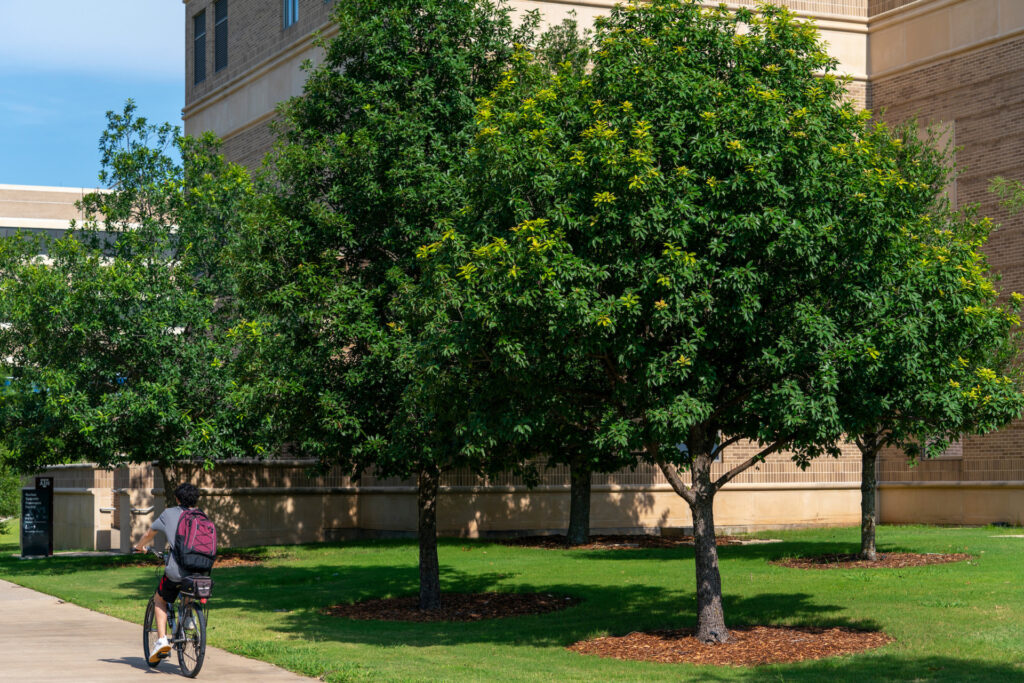Mexican white oak named Texas Superstar shade tree
Native tree offers aesthetics, Texas-toughness for all conditions
Looking for a Texas Superstar-worthy shade tree? The Mexican white oak fits the bill.

Mexican white oak, also known as Coahuila oak, Mexican oak, Monterrey oak, Monterrey white oak or net-leaf white oak, performs as a handsome shade, street or park tree across the state, said Mike Arnold, Ph.D., Texas A&M AgriLife Research horticulturist and Texas Superstar executive board member, Bryan-College Station.
The tree is a relative newcomer to the Texas nursery trade, but it has proven to be a great addition as a shade tree because it can tolerate hot, dry, windy conditions, he said.
With a unique blend of adaptability and beauty, this shade tree swiftly earned its place as a Texas Superstar plant, captivating both homeowners and landscaping professionals in the field.
Plant explorers found tree populations in Val Verde County in the 1990s, so both Texas and Mexico can claim the Mexican white oak as a native, Arnold said.
Its foliage, marked by an array of variable lobes, casts a canopy of green and hues of blue. In its youthful stages, this oak showcases an upright oval form before maturing into a medium-sized tree that’s perfect for shading streets, parks and gardens.
The tree’s rich, dense canopy is tardily deciduous in colder parts of its range to semi-evergreen in warmer areas, he said. Mexican white oak persists through the harshest of conditions, braving the sweltering Texas heat as well as winter temperature fluctuations.
“The Mexican white oak’s performance during winters of U.S. Department of Agriculture zone 7 and warmer portions of zone 6 have been impressive,” Arnold said. “It is rapidly becoming a welcome addition to the Texas plant palette.”
To be designated a Texas Superstar, a plant must perform well for growers throughout the state. Texas Superstars must also be easy to propagate, ensuring the plants are widely available and reasonably priced.
Mexican white oak has it all
Mexican white oak trees perform best in full sun and soils with good drainage. Trees appear to endure open exposures, even those with reflected heat, minimal irrigation and windy locations. Salinity exposure has not been fully documented, but the trees tolerate a wide range of soil pH and exposure to at least moderate salinity, as long as irrigation is applied via drip rather than overhead.

Typically, trees mature to a height of 35-45 feet but can grow to as much as 60 feet tall on more favorable sites, he said. They provide a well-proportioned canopy around single and double story structures, and with a spread typically two-thirds to equal its height, they offer a perfect blend of shade and aesthetic appeal.
Not only is the Mexican white oak a visual delight, but it’s also a boon for nature, Arnold said. It aids in soil stabilization and offers a bountiful supply of acorns to sustain wildlife populations in the fall.
As a hardy deciduous to semi-evergreen woody perennial, the Mexican white oak flaunts its beauty through the seasons, he added. Planting opportunities vary from fall in warmer regions to early spring and summer in cooler locations.
Despite its relatively recent introduction to the horticultural stage, the Mexican white oak has swiftly gained favor for its steadfastness in the face of environmental challenges, Arnold said. Trees also appear to tolerate humid climates with minimal foliar diseases, something seldom seen in xeric climate plants when moved to higher rainfall regions of the upper Gulf Coast.
Widespread planting of the tree has only occurred over the past two decades, which is a somewhat limited window for a long-lived tree. But its ability to endure environmental fluctuations during that time underscores its potential as a valued landscape addition to the South-Central U.S., notably in Texas.
Arnold said the Mexican white oak’s semi-evergreen nature, canopy shapes and foliar coloration is variable among genotypes, which makes the tree an interesting species for continued trials and breeding potential to improve cultivars.
At this time, relative susceptibility of Mexican white oak to oak wilt has not fully been documented, so Arnold recommends using soils where oak wilt has not been shown to be a problem.
“In a world where landscaping choices are more important than ever, the Mexican white oak stands as a symbol of resilience, adaptability and natural elegance — a true ‘superstar’ in the diverse tapestry of Texas flora,” Arnold said.
Texas Superstar is a registered trademark owned by Texas A&M AgriLife Research. Plants are designated by the Texas Superstar executive board, which is comprised of nine horticulturists from AgriLife Research, the Texas A&M AgriLife Extension Service and Texas Tech University in Lubbock.


